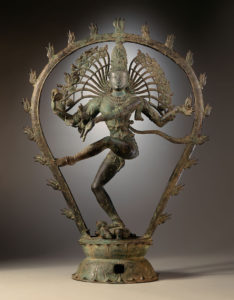
by Barrie
Natarajasana is derived from a pose in the classical Indian dance form Bharatnatyam. Perhaps this is why I find it to be one of the most elegant and beautiful forms in modern postural practice.
Nataraj means king or lord of the dancers. This pose honors Shiva in his form as cosmic dancer, the Lord of the Dance. It’s based on the famous form of the Shiva Nataraj, which is originally found in the Nataraja temple in Chidambaram in the south Indian state of Tamil Nadu. It portrays Shiva as the performer of the five universal functions: creation, sustenance, dissolution, concealment, and revelation.
In his upper-right hand Shiva holds a drum called a damaru, which signifies creation. In his upper-left hand is a flame, which symbolizes destruction. The lower left arm and leg crossing over his body represent concealment, the ways Shiva hides his presence. His near right hand is in the Abhaya mudra, a gesture of compassion and protection, symbolizing revelation or grace. The equanimity conveyed by Shiva’s facial expression represents the sustaining power of the absolute that remains steady and constant amidst the movement of the dance.
Just as Shiva performs these five acts all the time on the universal level, the tradition teaches that we to perform these five acts individually in the dance of our lives.
Consider the practice of asana. There is the creation of the pose, the holding phase where we sustain the pose, and then the dissolution as we release the pose. There might be moments in practice where we are distracted or feel incapable, where our power is somehow concealed to us in our experience. And there are moments where we feel expanded and capable. This can be seen as a kind of revelatory experience, where our innate power is revealed to us.
Observe how you enact these five acts as you practice the short sequence of poses in the video below. Through the focus of your gaze and the even rhythm of your breath, practice staying connected to the steadiness of your center within the movement of the poses.
PROPS NEEDED: one strap, one bolster, and a small amount of wall space.
If you are reading this post in your email, to view the video, you must click on the title of this post, “Baby Dancer (Natarajasana) Mini Practice.” This will link you to the blog itself, where you can play the embedded video.
Download Barrie’s free Guide to Home Yoga Practice right here. Learn more about her book Evolving Your Yoga: Ten Principles for Enlightened Practice and her online classes at www.barrierisman.com.
• Follow Yoga for Healthy Aging on Facebook and follow Nina on Instagram • Pre-order Yoga for Times of Change: Practices and Meditations for Moving Through Stress, Anxiety, Grief & Life’s Transitions here • Order Yoga for Healthy Aging: A Guide to Lifelong Well-Being here


Leave A Comment